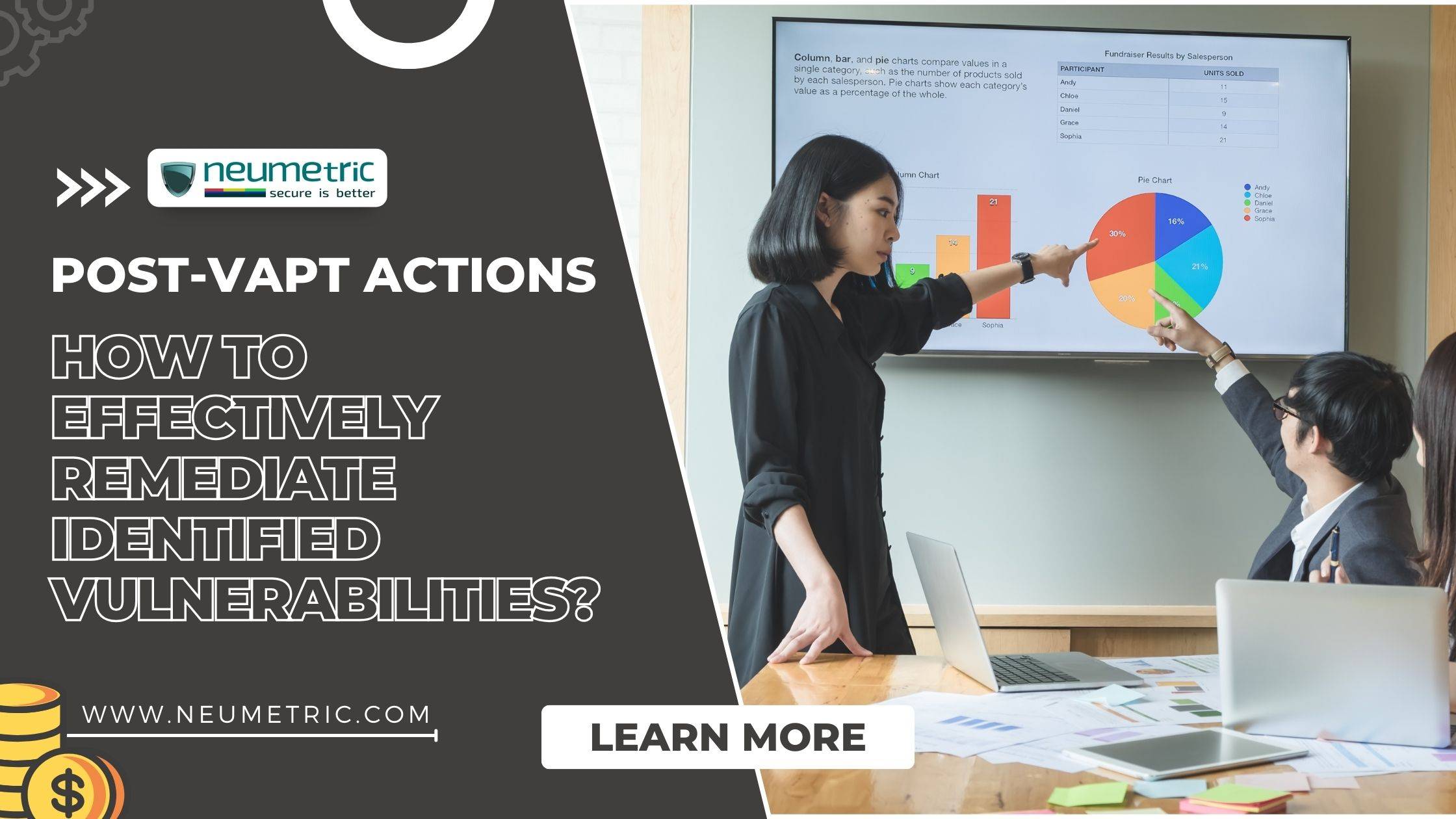Table of Contents
ToggleIntroduction
In an era dominated by digital landscapes, ensuring the robustness of your organization’s cybersecurity is paramount. Vulnerability Assessment & Penetration Testing [VAPT] have become indispensable tools in identifying potential weaknesses in your security posture. However, the true challenge lies in what comes next — the post-VAPT phase. This is where we roll up our sleeves & delve into the intricate process of effectively remediating the vulnerabilities unearthed during the assessment.
Understanding Identified Vulnerabilities
Before we can embark on the journey of remediation, it’s crucial to have a solid grasp of the vulnerabilities at hand. The VAPT process sheds light on a myriad of weaknesses, ranging from software vulnerabilities to configuration gaps & even human-centric lapses. By comprehending the diverse nature of these vulnerabilities, we lay the foundation for a targeted & efficient remediation strategy.
Prioritizing Remediation
Not all vulnerabilities are created equal. Understanding the risk associated with each one is key to prioritizing remediation efforts. It’s not just about fixing everything; it’s about fixing the right things at the right time. Conducting a thorough risk assessment, considering severity levels, & analyzing potential impacts on business operations help in crafting a prioritized list that guides subsequent actions.
Creating an Actionable Remediation Plan
With the vulnerabilities identified & prioritized, the next step is to create a detailed & actionable remediation plan. This involves collaboration among key stakeholders, assigning responsibilities, establishing realistic timelines, & considering budgetary constraints. A well-crafted plan serves as a roadmap, ensuring that everyone is on the same page & that efforts are streamlined toward effective remediation.
Implementing Quick Wins
In the world of cybersecurity, time is often of the essence. Quick wins involve addressing critical vulnerabilities promptly. Immediate fixes, patches, & configurations that provide instant improvements to your security posture fall under this category. Not only do quick wins enhance your overall resilience, but they also showcase tangible progress to stakeholders, fostering confidence in the remediation process.
Patch Management & Software Updates
A robust patch management strategy is the linchpin of effective vulnerability remediation. Automating the patching process ensures that your systems are fortified against known vulnerabilities. Timely software updates further fortify your defenses, closing potential entry points for malicious actors. This ongoing commitment to system health is instrumental in maintaining a proactive security stance.
Employee Training & Awareness
Beyond technical aspects, human-centric vulnerabilities demand attention. Employees, often unknowingly, can become the weakest link in your security chain. Conducting regular security awareness programs, educating staff on best practices, & reinforcing the importance of secure behaviors create a culture of vigilance & responsibility, significantly reducing the risk of human-induced vulnerabilities.
Continuous Monitoring & Testing
Cyber threats evolve, & so should your security measures. Implementing continuous security monitoring & regular penetration testing ensures that your defenses remain resilient against emerging threats. This proactive approach identifies vulnerabilities as they emerge, allowing for timely remediation & reducing the window of opportunity for potential exploits.
Collaborating with Third-Party Experts
In the complex realm of cybersecurity, collaboration is key. Engaging with third-party cybersecurity consultants & building partnerships with security vendors provide access to specialized expertise. Leveraging external knowledge enhances your ability to address complex vulnerabilities & reinforces the layers of defense around your digital assets.
Post-Remediation Assessment
Once the remediation dust settles, it’s crucial to evaluate the effectiveness of your efforts. Conducting follow-up VAPT assessments ensures that the identified vulnerabilities have been successfully mitigated. This iterative process of assessment & improvement is essential for maintaining a robust security posture over the long term.
Reporting & Communication
Communication is the glue that holds the entire remediation process together. Regularly updating stakeholders on progress, being transparent in reporting, & articulating the positive impact of remediation efforts build trust. This open communication loop is vital for maintaining support & understanding the ongoing commitment to cybersecurity.
Conclusion
Effectively remediating identified vulnerabilities is not a one-time task but an ongoing commitment to the security & resilience of your organization. By understanding, prioritizing, & systematically addressing vulnerabilities, you not only strengthen your defenses but also foster a culture of cybersecurity awareness. The post-VAPT phase is a dynamic process that requires collaboration, continuous improvement, & a proactive approach to stay one step ahead of cyber threats.
FAQs
Why is it essential to prioritize remediation efforts after a VAPT assessment?
In the cybersecurity realm, not all vulnerabilities are created equal. Prioritizing remediation efforts allows organizations to focus on fixing the most critical weaknesses first. This strategic approach ensures that resources are allocated efficiently, addressing the vulnerabilities that pose the highest risk to the business. It’s about tackling the right issues at the right time to enhance overall security resilience.
How do quick wins contribute to the effectiveness of vulnerability remediation?
Quick wins play a pivotal role in the cybersecurity playbook. By swiftly addressing critical vulnerabilities, organizations shore up their defenses in a timely manner. Immediate fixes, patches, & configurations not only strengthen the security posture but also demonstrate tangible progress to stakeholders. Quick wins are the rapid-response actions that make a significant impact on overall cybersecurity, showcasing a proactive commitment to digital defense.
Can you explain the importance of continuous monitoring & testing in post-VAPT actions?
In the ever-evolving landscape of cyber threats, continuous monitoring & testing are like the watchful guardians of your digital realm. By implementing ongoing security monitoring & regularly conducting penetration tests, organizations stay ahead of emerging threats. This proactive approach ensures that vulnerabilities are identified as they surface, allowing for prompt remediation. It’s a dynamic process that reflects the commitment to staying one step ahead in the game of cybersecurity.


